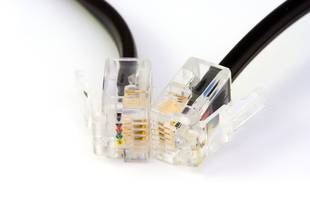
Modem, short for modulator-demodulator is an electronic device that converts a computer's digital signals into specific frequencies to travel over telephone or cable television lines. At the destination, the receiving modem demodulates the frequencies back into digital data. Computers use modems to communicate with one another over a network.
The modem has significantly evolved since the 1970s when the 300-baud modem was used for connecting computers to bulletin board systems (BBSs). With this type of modem each bit, represented digitally by a 1 or 0, was transmitted as a specific tone. The receiving modem responded with its own dedicated frequencies so that the modems could "talk at the same time." The technical term for this type of modem is asynchronous.
While the 300-baud modem could transmit about 30-characters per second, fast enough for text-based BBSs, people were soon sharing programs and graphics. This required faster modems, and the modem went through many incarnations in rapid succession over the following three decades. By 1998 the standard dial-up modem maxed-out its transmission range at 56 kilobits per second. While many tens of times faster than the 300-baud modem, far greater speeds could yet be reached with an Asymmetric Digital Subscriber Line (ADSL) modem.
The designation asymmetric simply means that the modem is faster at downloading (getting data), than uploading (sending data). The ADSL modem has significant, immediate advantages over the dial-up modem. Though it uses a standard telephone line like a dial-up modem, it does not tie up the line, making it possible to use the telephone while cruising the Internet. ADSL service is an "always on" connection, unlike a dial-up modem that cannot be left connected indefinitely. Finally, the ADSL modem is far faster than a dial-up modem.
The ADSL modem can accommodate a telephone conversation because of available bandwidth on the dedicated copper wire, which runs from households and businesses to the telephone company. A parallel can be made to a multi-lane freeway with several lanes open for additional traffic. The ADSL modem uses the additional lanes (higher frequencies) without interfering with existing voice traffic. An ADSL modem requires ADSL service through an Internet Service Provider (ISP). This type of modem will now work with a dial-up account.
Some businesses require as much bandwidth going upstream as downstream. This means they need to upload large files or programs to the Internet, as well as download large files. For equal bandwidth in both directions, one would need a Symmetric DSL (SDSL) account and SDSL modem. The SDSL modem uses voice traffic lanes to expand bandwidth, and therefore a conversation is not possible when the SDSL modem is connected. For this reason most businesses use a dedicated phone line with an SDSL modem.
Yet another type of modem uses cable TV wiring rather then the phone line to provide Internet connectivity. A cable modem requires service from a cable TV provider for Internet connectivity. The cable modem works on the same principle as the DSL modem, in that digital data is transferred across wires using frequencies that are translated back into digital data. Frequencies used for data traffic do not interfere with existing TV traffic.
A less common modem is a satellite modem, or satmodem. The satellite modem converts digital data into radio waves to communicate with a satellite dish. This not only involves a built-in latency factor in most cases, but the service is more expensive than more conventional types of Internet connectivity. A satellite modem can be an option, however, for businesses or enthusiasts in rural areas that do not yet have DSL or cable service offerings.


















